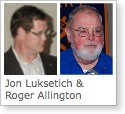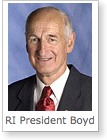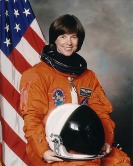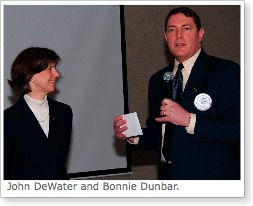 VOL 19, NO 33, FEBRUARY 27, 2007 |
||||||||||||
|
||||||||||||
Friday Program: Dunbar, grew up on a ranch near Yakima in the community of Outlook. She decided by the time she turned 10 that she wanted to be an astronaut. After holding research and engineering positions with The Boeing Co., Harwell Laboratories and Rockwell International, she joined NASA as a flight controller. History and Bonnie’s life goals changed on October 4, 1957, when the Soviet Union successfully launched Sputnik I the world first satellite. (The Sputnik launch led directly to the creation of National Aeronautics and Space Administration (NASA). In July 1958, Congress passed the National Aeronautics and Space Act (commonly called the "Space Act"), which created NASA as of October 1, 1958, from the National Advisory Committee for Aeronautics (NACA) and other government agencies.)
Rotary’s Birthday Celebrated by a Visit from Paul Harris Today, the world’s oldest service club organization, is a global network of more than 31,000 clubs in 165 countries. There are 529 RI districts, each led by a governor, who is an officer of Rotary International. The world's first service club, the Rotary Club of Chicago, Illinois, USA, was formed on 23 February 1905 when Harris, an attorney, wished to recapture in a professional club the same friendly spirit he had felt in the small towns of his youth. The name "Rotary" derived from the early practice of rotating meetings among members' offices. Who could have imagined? Rotary's popularity spread throughout the United States in the decade that followed; clubs were chartered from Seattle to San Francisco to New York. By 1922, Rotary clubs were formed on six continents, under the organization’s new name Rotary International. As Rotary grew, its mission expanded beyond serving the professional and social interests of club members. Rotarians began pooling their resources and contributing their talents to help serve communities in need. The organization's dedication to this ideal is best expressed in its principal motto: Service Above Self. Rotary also later embraced a code of ethics, called The 4-Way Test, that has been translated into hundreds of languages. Student of the Month is Bellevue Christian’s Rachel Fenske Rachel is a 3.9 student who is gifted in the arts, with an emphasis in film production, drama, and design. She has received numerous awards in the arts, drama, school and community spirit, and filmmaking. Her greatest source of pride in participating in “community service” was her journey this past summer to Mississippi to help the needy children and families who are trying to rebuild their lives and communities. Next year, Rachel will live and work in Norway before she returns to attend college and pursue her goal of being a movie photographer, editor, and director. GSE Committee Encourages Club Members to Host Group Study Exchange Team from Japan’s Rotary District 2770 GSE has been for the past 41 years, the most outstanding Rotary Foundation vocationally focused world peace and friendship program. Since 1965, GSE has provided inspiring vocational, educational, and cultural experiences for more than 32,000 professional men and women Bellevue Breakfast Rotarians will share the hosting of the GSE Team members with the Bellevue Noon Club members and their families. BBRC President Jim and Sandy will be hosting Team Leader, Naohiro Emoto, a Rotarian and CPA. The GSE Committee is seeking hosts for Atsushi Oba, who is interested in international marketing and works with Nissan Diesel Motor Co. Ltd.; Emiko Ozawa, a property tax specialist who has interests in "urban design" and the arts as well as digital government applications; Masahiro Yoshida, a tax consultant with interests in snowboarding, soccer, and learning about American accounting standards and corporate management; and Yuko Hasunuma, who works with Daiwa Securities and is interested in corporate finance, karaoke, and cultural exchange. (Robin please insert link to RI District 5030 website where there are photos and longer profiles of the GSE Team members). If you are interested, please contact (Ph 425-868-4282 or 425-890-6427) or (Ph 425-785-8182) as soon as possible World Community Service Project Proposal Guidelines
Simply put, the committee determined that applying these filters, in most cases, means that we hold external funding requests until all BBRC members have had an opportunity to engage in international service by leading or championing an international service effort. As we get closer to the end of the Rotary year, we want to make sure we have all requests for BBRC sponsored international projects in for funding review. So, if you are planning an international service effort this Rotary year, as soon as possible so I can get your request into the committee before we move to the next level (meeting funding requests of other Rotary clubs, Rotarians outside the BBRC and district projects). President Boyd & Rotary International Designate February “World Understanding Month” Dear fellow Rotarians,
While talking to a bamboo-stool maker, Yunus learned that the woman purchased her supply of bamboo on credit, for roughly 25 U.S. cents, every morning. Lacking the money for even a single day’s supply of bamboo, she would never be able to repay the loan. Throughout the village, Yunus found many in similar straits. Their total debt? Twenty-seven U.S. dollars. Yunus did what was, for him, the natural thing: He paid their debts. The new entrepreneurs quickly turned a profit, his loan was repaid, and microcredit was born. The idea of giving small loans to the very poor was a revolutionary one, and it has had revolutionary results. In 2005 alone, 100 million microcredit loans helped people in 130 countries. Today, Rotarians are involved in more than 60 microcredit projects around the world. In 1999, Yunus was honored at the RI Convention in Singapore. In October, he received the Nobel Prize. The simple principle of microcredit is also a principle of Rotary. Small changes can become great changes, and a seemingly inconsequential act can have tremendous consequences. Just as 25 cents in that Bangladeshi village meant so much more than merely a quarter of a dollar, the prosperity of an unnoticed individual or village has international implications. As we enter World Understanding Month, we are reminded by Yunus’ achievement that we can never know every consequence of what we do. His loan of $27, given in compassion, led to far more good than he could possibly have imagined. Our Rotary work also leads to benefits we will never see: new friendships, new connections, warm feelings among people who may have little in common. Poverty, as we know too well, is a tremendous obstacle to peace and stability. So, every intelligent act of generosity, every project that helps others to lead better lives, is also an act of hope. We Rotarians share the belief that love for others does make a difference. Each small act of kindness, from one human being to another, brings us closer to each other and to the kind of world we hope to leave to our children. We may think we are only helping to equip a school, supply a clinic, or build a well for a faraway community. But in truth, what we are doing is helping to build a better, more stable, and more peaceful future. W.B. (Bill) Boyd
Friday Program: Dunbar, grew up on a ranch near Yakima in the community of Outlook. She decided by the time she turned 10 that she wanted to be an astronaut. After holding research and engineering positions with The Boeing Co., Harwell Laboratories and Rockwell International, she joined NASA as a flight controller. History and Bonnie’s life goals changed on October 4, 1957, when the Soviet Union successfully launched Sputnik I the world first satellite. (The Sputnik launch led directly to the creation of National Aeronautics and Space Administration (NASA). In July 1958, Congress passed the National Aeronautics and Space Act (commonly called the "Space Act"), which created NASA as of October 1, 1958, from the National Advisory Committee for Aeronautics (NACA) and other government agencies.) Dunbar earned bachelor's and master's degrees in ceramic engineering from the University of Washington in Seattle and a doctorate in mechanical/biomedical engineering from the University of Houston. She held research and engineering positions with the Boeing Co., Harwell Laboratories and Rockwell International until 1978, when she joined NASA as a flight controller. In 1980, she realized her dream to become an astronaut and went on to fly five missions aboard the shuttles Atlantis, Challenger, Columbia and Endeavor and has logged 1,208 hours — more than 50 days. Her mission aboard Endeavor, was in January 22–31, 1998. As payload commander on this mission, she was responsible for more than four tons of scientific equipment, supplies and water for delivery to the Russian space station Mir, as well as twenty-three scientific experiments aboard the shuttle.
"Part of the reason we honor the past," commented Dunbar, "is to inspire the future. The Museum of Flight has established a worldwide reputation for the depth of its commitment to education and the quality of its programs that use the wonder of flight to inspire learning." How do you know where you are going if you do not know where you have been? The independent, non-profit Museum of Flight is one of the largest air and space museums in the world, attracting more than 400,000 visitors annually. The Museum's collection includes more than 150 historically significant air- and spacecraft, as well as the Red Barn® — the original manufacturing facility of The Boeing Co. The Museum's aviation and space library and archives are the largest on the West Coast. More than 100,000 individuals are served annually by the Museum's on-site and outreach educational programs. The Great Gallery is a 3 million-cubic-foot, six-story glass-and-steel exhibit hall currently containing 39 full-size historic aircraft, 23 of which — including the nine-ton Douglas DC-3 — hang from the space-frame ceiling in flight attitude. The Museum of Flight's collection of aerospace artifacts is the largest and most comprehensive in the western United States. A half-million people visit the Museum as well. We're trying to inspire the future by preserving the past and inspire our children and youth to study math and science. Education is Dr. Dunbar’s passion and she passionately supports the Museum’s work with K-12 students. "The Museum of Flight has 80,000 students come through a year. The Museum of Flight provides quality "experiential learning" opportunities for K-12 students with decades of experience behind its current 22 programs, including the Challenger Learning Center (CLC), the Aviation Learning Center (ALC), and it summer Aerospace Camp Experience (ACE). The MOF learning experiences are aligned with the Washington State Essential Learning Skills requirements and are guided by an Education and Learning Advisory Board (ELAB) composed of more than 40 educational specialists from throughout the State of Washington. Nearly 100,000 K-12 students are served annually with more than 500 schools served in last year.
Aviation High School (a partnership with Highline School District) and the Washington Aerospace Scholars Program for high school juniors are two among the 22 programs are major initiatives that The Museum of Flight is supporting to encourage and support students in Washington State to study math, science, engineering, or computer science by interacting with engineers and educators involved in aerospace. Dunbar explained, “For more than a decade, the declining numbers of engineers and physical scientists produced by Universities in the United States has concerned many sectors of the nation. The declining numbers of engineers impact the creativity, productivity, and economic well being of the nation. The actual enrollment numbers have been formally tracked by the National Science Foundation since post World War II, 1945. The peak in engineering enrollment occurred in 1987 and has been declining since. Similar trends have been occurring in the physical sciences and mathematics. In 1956, pre Sputnik, the US graduated twice as many bachelor degrees in Physics as in 2004.” “The lack of qualified science, mathematics, and engineering graduates has been cited by Washington State Companies, such as the Boeing Company, and Microsoft, as being an underlying reason for moving business activities, e.g., research and development, off shore to other countries such as India and China where engineering enrollment is increasing while USA university enrollment is decreasing. In 2004, China graduated 350,000 engineers, computer scientists and ITs with 4 year degrees. The US graduated 140,000. Less than one third of US 4th grade and 8th grade students performed at or above a level called "proficient" in mathematics on national exams. The Washington Aerospace Scholars program is well postured to enlarge the pipeline of students who are prepared to enter college and graduate with a degree in science, engineering, or mathematics by increasing the number of students who pass AP and IB science and mathematics courses. We will be creating opportunities and incentives for middle school and high school students to pursue advanced work in science and mathematics. NASA developed the on line curricula in collaboration with educational specialists. It is aligned with state standards. NASA will provide this curricula to the WAS and will provide start up guidance and mentorship. The curricula will be modified, when required, to the Washington State Standards. The summer experience, described below, will occur on site at the Museum of Flight.” Dr. Dunbar concluded her presentation by cluing us into the video, “The Knack,” starring Dilbert, a humorous comic film clip that has been going around the world of math/science nerds. Memphis Gas Station A gas station in Memphis was trying to increase its sales, so the owner put up a sign saying, "Free Sex With Fill-Up". Soon a good ol' boy named Billy Ray pulled in, filled his tank, and asked for his free sex. The owner told him to pick a number between 1 and 10. If he guessed correctly, he would get his free sex. Billy Ray guessed 8, and the proprietor said, "You were close. The number was 7. Sorry, no sex this time." A week later, Billy Ray pulled in again, this time with his buddy Buford, and asked for a fill-up. He then asked for his free sex. The proprietor again gave him the same story, and asked him to guess the correct number. Billy Ray guessed 2 this time, and again, the proprietor said, "Sorry, it was 3. You were close, but no free sex this time." As they were driving away, Billy Ray said to Buford, "I think that game is rigged and he ain't really gonna give away no free sex. " Buford replied, "No, it ain't rigged, Billy Ray. My wife won twice last week!"
|
|
|||||||||||










 A Community Service Work Party scheduled for March 10th, from 8:00 am– 12:00 noon. Led by Kevin Jewell and Ron Healey, BBRC members will be washing, painting, repairing, and improving the interior and exterior, including the yard, of a home in the Bellevue area.
A Community Service Work Party scheduled for March 10th, from 8:00 am– 12:00 noon. Led by Kevin Jewell and Ron Healey, BBRC members will be washing, painting, repairing, and improving the interior and exterior, including the yard, of a home in the Bellevue area. 